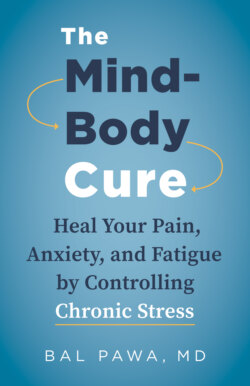Читать книгу The Mind-Body Cure - Bal Pawa - Страница 32
На сайте Литреса книга снята с продажи.
SELF-ASSESSMENT
ОглавлениеOur brain is designed to be efficient and to automatically streamline the activities of daily life, especially repetitive ones. We become creatures of habit: doing the same things, buying the same food, cooking the same way, and even sitting at the same seat every day. We are unaware that our brain is running things automatically with no conscious input.
Do you:
have a morning routine (for example, get up, go to the toilet, prepare your coffee . . .)?
have a favorite mug for your coffee or tea?
sit in the same seat at the table, at the movies, or on the bus?
walk into the kitchen and automatically open the fridge door?
eat reflexively when you see food ads?
go to familiar Internet or YouTube sites?
consistently buy the same colors and types of clothing?
run on autopilot and wonder why you ended up in a particular place or doing something you didn’t intend to?
rely on tried-and-trusted routines rather than explore new ones?
stick to familiar comforts rather than challenge yourself?
While our mind is busy creating thoughts, feelings, attitudes, beliefs, and memories, the brain plays a central role in translating them into electrical and chemical signals that send complex communications to the rest of the body using hormones and neurotransmitters. It also consolidates and stores the memories of all our experiences. In addition to these roles, the brain’s main functions are to maintain balance within the body, be vigilant for external cues, be efficient, and above all keep us safe from danger. The brain is very busy!
Much of the time the brain can act automatically, which makes our lives easier and more efficient. It can memorize functions and habits, such as getting up in the morning and automatically reaching for a toothbrush and toothpaste or driving a car, allowing the conscious mind to be “offline” to focus on other things. However, our brain is hypersensitive to danger signals and perceives any disruption to its regular functioning as various degrees of stress. It is our mind that gives meaning to a situation after perceiving external cues and decides whether we react in fear or in trust. When we interpret a situation as dangerous, our brain turns on the fight-or-flight reaction instantly. Built-in protective mechanisms—such as an increase in blood pressure, heart rate, and blood sugar levels—allow us to react quickly to danger or threat. In this way, short-term stress keeps us out of harm’s way and protects us.
This high level of vigilance has been beneficial to humans as we’ve evolved, allowing us to survive actual threats such as attacks from predators, infections, and countless natural disasters. However, while our frontal brains have become larger and more sophisticated over time—leading us to explore space, develop medical robotic surgery, and create advanced computer technology—the primitive brain responsible for our fear reaction has remained basic in design. While most of us no longer have to worry about being the next meal for predators in the jungle, our mind often creates thoughts of guilt, anger, fear, resentment, and being “busy” that can create the same fear reaction provoked by the sight of a saber-toothed tiger. Our mind’s automatic thoughts, or remembered sounds, sights, or smells of danger, can turn on the fight-or-flight reaction. In other words, the mind creates stress and the brain activates our body’s stress hormones. By thought alone, the brain can be tricked into sending visceral messages to the body about a threat that is not actually present.
Sometimes the memory of danger can become so embedded in the brain after many repetitions that it becomes automatic, such that we continually react to a perceived instead of an actual threat. Perpetual thoughts of stress, whether real or imagined, keep our stress hormones continuously activated. And prolonged, chronic stress shrinks the brain and causes a profound change in its chemistry, biology, and electrical circuits—changes that affect our memory, mood, and functioning. To understand why, we need to know a bit about our brain.
